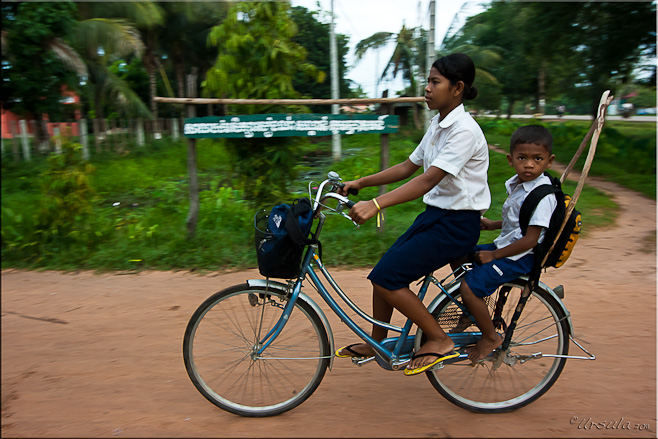
Coming into School in the Morning – Sandan School, Cambodia
Cambodia is a youthful country with a sad history.
One third of the country’s 15 million people (32.2%) is under the age of fifteen (July 2011 est.).
Given the genocide perpetrated by Pol Pot and the Khmer Rouge between 1975-1979 when two million Cambodians were killed, it is not surprising that less than 4% of the population is 65 or over. During the Khmer Rouge regime, educated people were targeted in the name of “agrarian socialism”. Thousands of teachers were amongst those executed after the fall of Phnom Penh in 1975.
So, the education system had to rebuild from scratch, along with the rest of the country’s infrastructure, and this could only start properly after the end of the civil war in 1990. Today, there are a lot of children – and still too few educated adults. This puts a lot of pressure on the country’s schools. On average, students stay in school for ten years, attending half a day of classes (four hours), either in the morning or in the afternoon, six days a week. Those who can afford it also attend evening “tutoring” classes. A number of parents told me that many teachers put all their energy into these tutoring classes; they said that teachers ignore the curriculum during their normal classes so that students have to pay the extra if they wish to pass the exams. If true, this is disappointing, but, given teachers’ pay scales and work loads, not terribly surprising.
I’ve visited Cambodia a number of times in the past to participate in an annual professional conference for the local teachers. This latest trip, however, was for me – I was there with my camera and with four gifted professional photographers: Karl Grobl, Marco Ryan, Gavin Gough and Matt Brandon. Still, I couldn’t resist visiting a local school, to see what was happening.
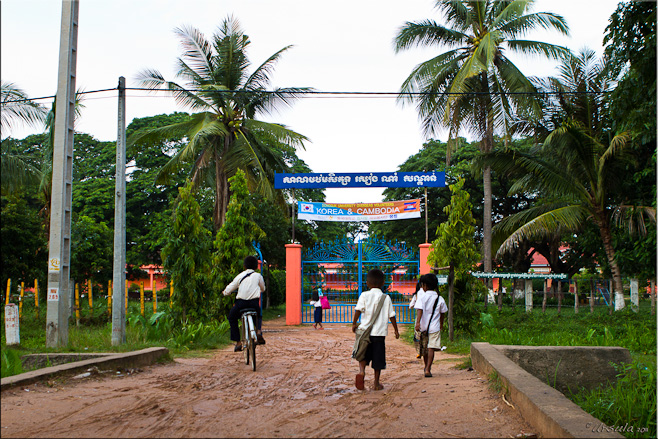
Arriving at School in the Morning – Sandan School, Cambodia
As you’d expect, the schoolyard in the morning is a lively place. Children arrive early: on foot, on oversized bicycles, ferried by their older siblings, or piled onto motorcycles or scooters driven by parents on their way to work. Children buy snack food from local vendors. They sweep the rooms and the yard, and unstack the desks in the classrooms. The boys play tag or marbles in the packed-dirt yard, while the girls skip or play a local version of Jacks on the veranda – all before the bell rings at eight o’clock.
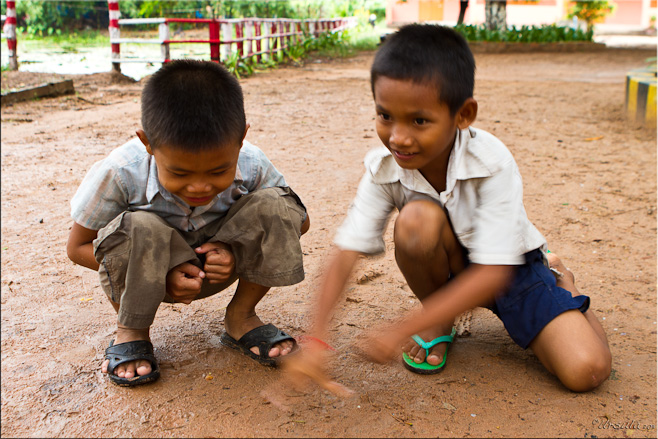
Boys flicking marbles. The object seems to be both distance and knocking your opponent out of play – like curling or boules.

A good marble-flicker shows off his winnings: a collection of cat’s eyes.

Young girls playing a game resembling jacks with coloured bits of plastic.

Skipping elastics on the verandah.

Fancy Footwork

Sweeping the yard? These boys aren’t very focussed, but the job got done.

No shoes indoors!

Preparing for the day: young girls sweep the verandah.

First-grader with her snack-in-a-baggie.

Too young for class : Younger siblings hang around the classrooms.

Kids love the camera! The camera loves kids!

Boys – waiting in the classroom.

The teacher is here – the class is ready.

Learning letters and spelling rules

Kids in the Classroom

Careful work. (When was the last time you saw a chalkboard?)

Checking Answers

Proud of his work…

“I think it is correct.”

Flashcards hang along the ceiling.

Children are expected to pay for their classroom tests and materials.

End of class… until the afternoon children arrive.

End of the school day… except for the extra tutorial classes.
It is always a joy to visit Cambodia. In general, the people are gentle mannered, softly spoken, and welcoming. The Cambodian teachers I’ve met at conferences have always been enthusiastic participants in the papers I have presented and the workshops I have run. They have demonstrated a real thirst for input and a willingness to learn and improve. The teachers I interacted with at this little local school were similar: overworked and underpaid, but enthusiastic, energetic, and trying to do the best for their pupils.
The social infrastructure of a country tells you a lot about its values. Good education, like adequate health care, is, in my opinion, the cornerstone of social justice in a community. Education (which may or may not be the result of good schools) is important to a population’s future, and even more critical in developing countries where the pace of change means that children will have to make choices about how to merge traditional values with international possibilities.
 Although international aid accounted for about half the national budget in 2010, Cambodia spends only about two percent of its GDP on education. Schooling is free to students; perhaps the government thinks it is free to them also.
Although international aid accounted for about half the national budget in 2010, Cambodia spends only about two percent of its GDP on education. Schooling is free to students; perhaps the government thinks it is free to them also.
Unfortunately, you often get what you pay for.
The teachers and children in these schools deserve better.
– CIA Factbook, Updated Nov. 8, 2011


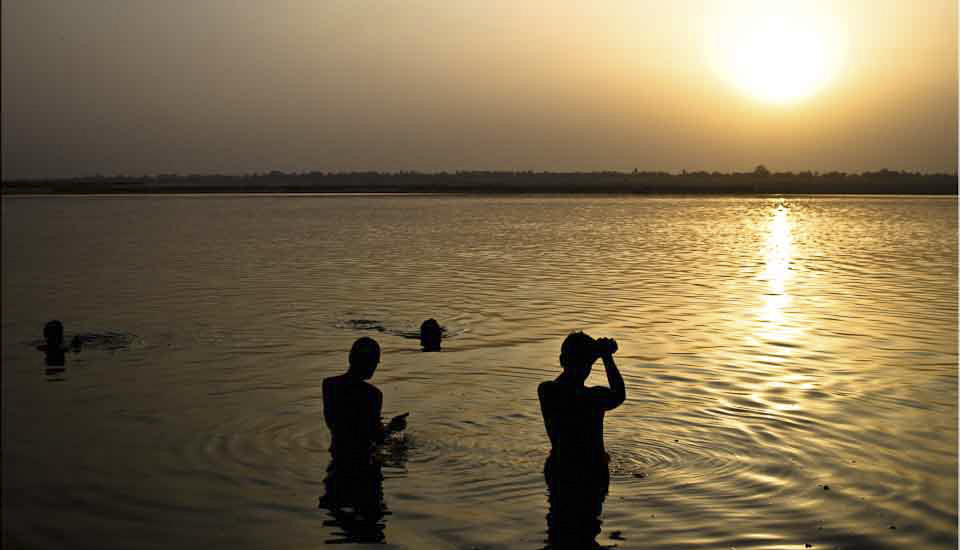

























.png)
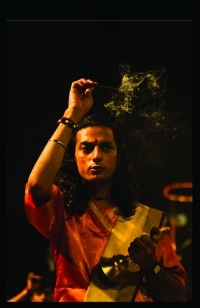
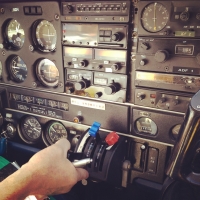
This is lovely, almost a story book quality to its sequence. Your hard work is evident; you have created a reflective and warm series of images.
Hi Carol,
So pleased you stopped in and enjoyed the story! 😀
I enjoyed visiting with the kids – more about them next week. 😉
I have to agree the camera loves kids, and how could it not, those fresh faced young people and deservedly proud of their work. We here do take our education for granted and whilst I will continue to fight for equality for our public school students vs our private schools, our children do get a great deal in comparison and sadly (although almost expected) resent the drudgery of attending day in day out… bless those young minds and those who struggle in difficult circumstances to get the basics through.
I agree that good education and adequate health care is the cornerstone of social justice. Our children are our future – where ever we live – and I hope these little ones do indeed have a bright future. Wonderful images.
Anna :o]
Thanks, Signe and Anna.
These kids have such potential! 🙂
Excellent photo essay Ursula. I visited Cambodia several years ago. For a country that has been through so much, the people are wonderful and welcoming. Your post has got me thinking that I should return!
Hi Kevin,
I’m so glad you enjoyed it. You’d love a photo tour! I can’t recommend Karl Grobl’s trips highly enough (bookings through Jim Cline). I know Karl (with Gavin, Matt and Marco Ryan) is planning another trip next July. 😀
[…] met Sony, the eldest of the four siblings, the first morning I visited Sandan School. She’s a bright girl, and was lucky enough to be chosen to attend the Jay Pritzker […]
Another nice job, Ursula. I feel as though I was there. I visited some small rural schools in Buriram when I was a Peace Corps volunteer in the mid 1970’s and they weren’t much different than this one you captured so well in your photographs and words. Thanks, for sharing.
Thanks for the visit, Patrick!
It is sad, in a way, that things have changed so little since the 70’s. The children in these rural schools are delightful, but it is hard to know what educational opportunities they actually have.
Ha Ha, John!
I, on the other hand, was bad at marbles, and skipping, and all those other non-book-related pursuits. Playgrounds were agony! 🙂